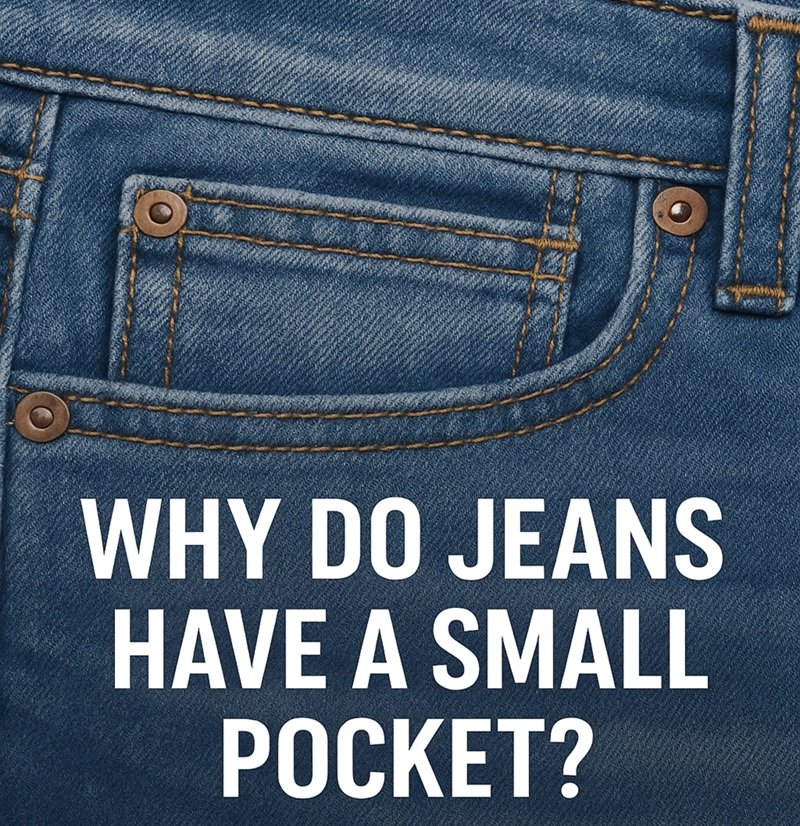
The Fascinating History Behind the Tiny Denim Companion
When you slip on a pair of jeans, you may not think twice about that small, seemingly useless pocket nestled inside the front right pocket. It’s too small to fit your phone, barely holds coins, and often goes unnoticed. But this miniature pouch has a rich, intriguing history that dates back more than a century. So, what exactly is the purpose of that small pocket on jeans, and why is it still around?
In this article, we’ll dive deep into the origins of the tiny jeans pocket, its transformation through the decades, and its role in today’s fashion world.
The Origin: Designed for Pocket Watches
The small pocket—commonly referred to as the watch pocket, coin pocket, or fifth pocket—was first introduced by Levi Strauss & Co. in the late 1800s. It was part of the original design for their 501 jeans, one of the earliest and most iconic denim styles in history.
At the time, pocket watches were essential accessories for men, typically carried on a chain and stored in a waistcoat. But cowboys, miners, and railroad workers—many of whom wore denim for durability—needed a safe, accessible place to stash their watches while working. Levi Strauss responded by sewing a small pocket into the front right pocket of their jeans in 1879, specifically sized to hold a pocket watch securely.
Key Features of the Original Watch Pocket:
- Sturdy and snug fit: Prevented the watch from bouncing or falling out.
- Easy to reach: Located in a practical position for quick access.
- Durable material: Reinforced with rivets to withstand wear and tear from tools and rough work environments.
From Function to Fashion: The Pocket Evolves
As pocket watches faded out of everyday use in the 20th century, replaced by wristwatches and later smartphones, the original purpose of the small pocket became obsolete. However, rather than being removed from jean designs, the small pocket stuck around, evolving into a quirky yet iconic part of denim heritage.
20th Century Use Cases:
- Coin storage: Many began using it for coins, giving rise to the term coin pocket.
- Matchboxes and Zippos: Smokers found it a handy place to store matchboxes or lighters.
- Tickets and small items: Ideal for holding train tickets, folded notes, or small tools.
Fashion brands also began incorporating the small pocket into various styles of jeans—from rugged workwear to designer denim—solidifying it as more than just a practical feature. It became a signature element of jeans’ identity, often maintained out of tradition and aesthetic continuity.
The Fifth Pocket: A Symbol of Jeans Culture
Though jeans typically have five pockets, many people are surprised to learn that the small pocket counts as the fifth pocket in standard designs.
Breakdown of the Classic Five-Pocket Jeans:
- Two front main pockets
- Two back pockets
- One small pocket inside the front right pocket (the watch/coin pocket)
Levi’s, in particular, continues to refer to it officially as the “watch pocket” in their designs and product descriptions. Its persistence reflects both a reverence for the brand’s roots and the overall cultural nostalgia attached to denim.
Modern Uses for the Small Pocket
Despite its diminishing functionality in the age of large smartphones and digital watches, the small pocket hasn’t disappeared. It may no longer hold pocket watches, but it still finds creative uses in everyday life:
- USB drives or small electronics
- Guitar picks
- Rings or small jewelry
- Headphone earbuds (wired)
- Lip balm or medication
- Emergency cash
Moreover, the pocket is often used as a design detail to enhance the jeans’ visual appeal. Some brands play with its size, stitching, or placement for stylistic effect.
Why Do Brands Still Include It?
There are several reasons why most jeans still feature the small pocket:
- Heritage and authenticity: Denim brands pride themselves on historical continuity, and the fifth pocket is a symbol of that.
- Brand identity: For classic brands like Levi’s, Wrangler, and Lee, omitting the pocket would feel like removing a key part of their DNA.
- Fashion consistency: Consumers are used to seeing it—it completes the classic denim look.
- Minimal cost: It’s relatively inexpensive to produce and adds perceived value to the garment.
Even fashion-forward designers who push boundaries with denim often retain the pocket, whether to subvert it creatively or honor its legacy.
Interesting Trivia About the Small Pocket
- Levi’s has confirmed that the small pocket has had over 20 different names in their product lifecycle, including “front pocket,” “ticket pocket,” and even “condom pocket.”
- The pocket is usually only found on men’s jeans or unisex designs. Women’s jeans often skip it or minimize it due to cut and fit priorities.
- It’s often the first pocket to fray, due to its exposed position and tight corners.
Conclusion: A Tiny Pocket With a Big Story
The small pocket on jeans may seem insignificant, but it represents more than a remnant of outdated fashion. It’s a time capsule of industrial design, practical necessity, and enduring style. From holding a cowboy’s pocket watch to becoming a canvas for fashion experimentation, this little denim detail tells the story of jeans themselves.
So the next time you slide your finger into that tiny pocket, remember—you’re touching a piece of history.







